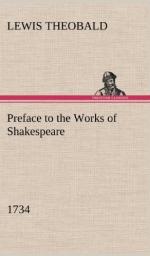Warburton apparently misunderstood or overlooked Theobald’s remarks about materials, for in his next letter Theobald was obliged to return, somewhat ambiguously, to the same point:
I make no Question of my being wrong in the disjointed Parts of my Preface, but my Intention was, (after I had given you the Conclusion, & the Manner in wch. I meant to start) to give you a List of all the other general Heads design’d to be handled, then to transmit to you, at proper Leisure, my rough Working off of each respective Head, that you might have the Trouble only of refining & embellishing wth: additional Inrichments: of the general Arrangement, wch. you should think best for the whole; & of making the proper Transitions from Subject to Subject, wch. I account no inconsiderable Beauty (Ibid., pp. 289-90).
Finally on January 10, 1733, Theobald wrote Warburton: “I promise myself now shortly to sit down upon ye fine Synopsis, wch. you so modestly call the Skeleton of Preface” (Ibid., p. 310).
It is clear from the foregoing that Theobald wrote most of the Preface topic by topic, and probably followed the plan for the general structure as submitted by Warburton. Yet it is equally clear that certain parts of the Preface, such as the contrast between Julius Caesar and Addison’s Cato, which Warburton later claimed as his and which Theobald omitted from his second edition, were furnished Theobald as “additional Inrichments” (D.N. Smith, Eighteenth Century Essays on Shakespeare, 1903, pp. xlviii-ix). When later a break did occur between the two men, neither was free from blame. Theobald had asked and got so much help with the Preface that he should have acknowledged the debt, no matter how naked it might have made him seem. Warburton, on the other hand, had had honest warning that acknowledgement would not be made for this part of his help; and if his synopsis were followed, as seems likely, his condemnation of the Preface as “Theobald’s heap of disjointed stuff” was disingenuous, to say the least. Far less defensible was his assertion in the same letter to Thomas Birch that, apart from the section on Greek texts, virtually the entire Preface was stitched together from notes which he had supplied (Nichols, Illustrations, II, 81).
Three further points concerning the Preface demand mention. First, the section on Shakespeare’s life is often dismissed as a simple recension of Rowe’s Life (1709). Actually, however, the expansion itself is a characteristic example of Theobald’s habit of exploring original sources. To take only a single instance, Rowe says that Shakespeare’s “Family, as appears by the Register and Publick Writings relating to that Town, were of good Figure and Fashion there, and are mention’d as Gentlemen” (ed. S.H. Monk, Augustan Society Reprints, 1949, p. ii). To this statement Theobald adds plentiful detail drawn from the same Stratford records, from tombs in the Stratford Church, and from documents in the Heralds’ Office connected with the coat of arms obtained for the playwright’s father. Such typical expansions were the result of conscientious research.




